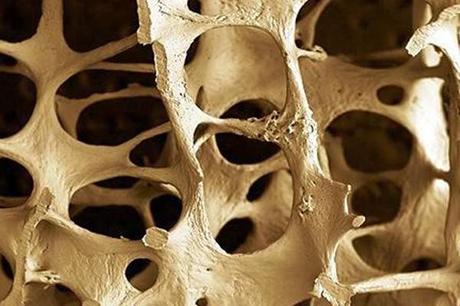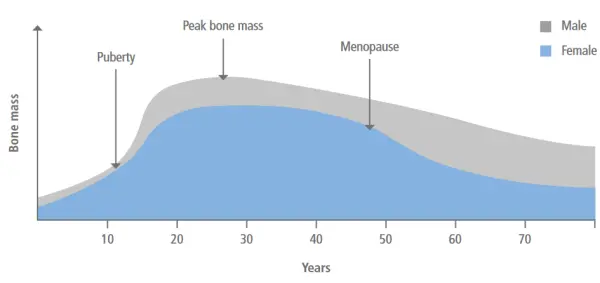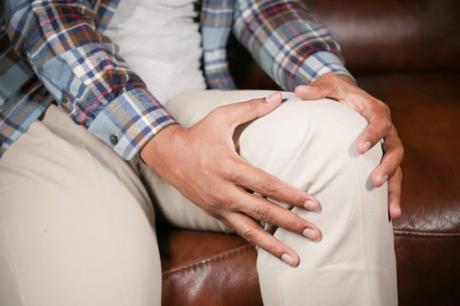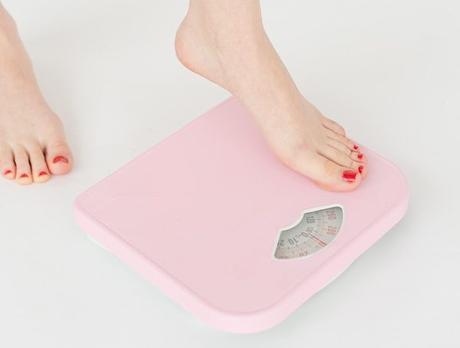Published: October 20, 2022 | Last Updated on: October 20, 2022 | by Hema
How to prevent Osteoporosis? Find out how you can keep your bones in top condition and ensure good health at every age with these diet, exercise & lifestyle tips.
Jump To hide What is Osteoporosis? Osteoporosis in Men v/s Women Signs of Osteoporosis Risk Factors for Osteoporosis Diagnosis of Osteoporosis How to prevent Osteoporosis: 12 Easy Tips Diet Tips to prevent Osteoporosis 1. Increase Calcium intake 2. Get the nutrients required for bone health 3. Get enough protein 4. Consider anti-nutrients 5. Cut down on salt 6. Go easy on the caffeine Exercise Tips to prevent Osteoporosis 7. Do regular weight-bearing exercise 8. Include muscle-strengthening workouts 9. Don’t forget balancing exercises Lifestyle Tips to prevent Osteoporosis 10. Maintain a healthy body weight 11. Quit smoking and drinking 12. Get some sun What to do if you have Osteoporosis References: Buy Healthy Nutritious Baby, Toddler food made by our own Doctor Mom !Have you ever been in a group of elderly female relatives and found them complaining about various aches and pains? If you listen closely, you’ll find that most of the complaints are related to their joints and bones. Well, it’s highly likely that at least some of them are suffering from osteoporosis, since studies show that 1 in 5 Indians over 50 have the condition!
Yes, osteoporosis is a widespread condition affecting not just Indians, but older men and women across the world. But what exactly is osteoporosis, and why is it such a big deal? With World Osteoporosis Day coming up on 20th October, we think it’s the right time to tackle these questions and learn more about this condition.


What is Osteoporosis?

Osteoporosis is a disease that causes bones to gradually weaken or become less dense. If left untreated, bones can become fragile enough to break easily.
Osteoporosis means ‘porous bones’ or ‘bones with holes’. When viewed under a microscope, a healthy bone has small spaces in between, but an osteoporotic bone will have more space and less bone, indicating lower bone density. The WHO defines a bone mineral density (BMD) of less than 2.5 as a confirmation of osteoporosis.
So how do our bones get weak? To understand this, we need to look at how our body maintains our bones. During our childhood and growing years, old bone tissue is routinely broken down and replaced by new bone tissue. This ensures we always have strong, healthy bones. This goes on till around the age of 30, which is when we have peak bone mass, also known as ‘PBM’.
However, as we age, this rate of replacing old bone tissue slows down. Towards the second half of our lives, more bone is broken down than is being replaced, which means that at any point in time, we have more old, unhealthy bone tissue. If left untreated, our bones get weaker and weaker, causing frequent fractures, mainly in the hip, back and wrist. This is why osteoporosis is more common in older people.
Osteoporosis in Men v/s Women
Our bone tissue also has a lot to do with our hormones, which is why women are more susceptible than men. As estrogen levels drop, bone loss increases and it is estimated that a woman can lose up to 10% of her bone mass in the years following menopause. Men also start out with more bone density than women, so the loss is not as rapid with them. Usually, by age 60-70, men and women are losing bone mass at the same rate. Here are some more facts about how osteoporosis affects men and women differently:
- 61% of osteoporosis fractures are seen in women
- 75% of all fractures of the hip occur in women
- Men are at greater risk of a fragility fracture than of prostate cancer
- Although women are more prone to fractures, men are more likely to have a fracture-related death
This graph gives a quick look at how bone mass changes with age and gender.

Signs of Osteoporosis
Osteoporosis is a serious disease, affecting 500 million people worldwide, and causing nearly 9 million fractures every year. Unfortunately, it is difficult to tell if you have osteoporosis simply by an external examination. Osteoporosis is usually undiagnosed till a fracture happens, due to which it is called a ‘silent disease’. By this point, the bones have already lost a significant amount of strength. This is why it is important to take steps to prevent osteoporosis and also diagnose it early.
Yet, there are some sneaky signs that can signal the loss of bone mass. Joint pain, swelling, and a stooping posture are all early signs of osteoporosis, although not everyone experiences them. Some people may also seem to get shorter, as a loss in bone density of the spine affects the vertebrae. Since it’s hard to know exactly when you get osteoporosis, it helps to know if you are at risk of getting the illness by assessing your risk factors.

Risk Factors for Osteoporosis
- Being over the age of 50
- Being Asian or Caucasian
- Early menopause
- Having had fractures previously
- Family history of osteoporosis
- Surgical Removal of ovaries
- Small body frame
- Excessive weight loss
- Nutritional deficiencies, particularly of Calcium and Vitamin D
- Sedentary lifestyle
- Smoking, drinking, or drug abuse
- Consumption of certain medicines, including steroids or medication for asthma, seizures, arthritis, or cancer
- Having an illness that prevents proper absorption of nutrients, like Crohn’s disease or celiac disease
- Chronic illnesses like bone marrow illnesses, autoimmune disorders, gastrointestinal illnesses or hormonal disorders
- Medical procedures like gastrectomy, gastrointestinal bypass procedures, weight loss surgery, or organ transplant
- Pregnancy and breastfeeding (specifically for Pregnancy and Lactation Associated Osteoporosis or PLO)
- Low levels of testosterone, in men
Depending upon the cause, osteoporosis is classified into primary and secondary osteoporosis.
Primary Osteoporosis can be Type I (due to menopause) or Type II (due to old age)
Secondary Osteoporosis is due to a pre-existing medical condition or long-term use of medications like steroids
Osteopenia is a condition where the bones are weak, but not fragile enough to be diagnosed as osteoporosis. It is usually considered to be the stage before osteoporosis.
Diagnosis of Osteoporosis

Since osteoporosis doesn’t really have any symptoms to speak of, it is recommended to test your bones regularly once you’re over the age of 65, especially if you’re female. If you have any of the risk factors listed above, it makes sense to get tested earlier.
There are multiple ways to test for osteoporosis, and the accuracy differs for each.
1. Dual-energy X-ray absorptiometry (DXA) or Bone Mineral Density Test (BMD) – This is the most accurate way to diagnose osteoporosis. Testing can be done on any bone of the body, and you can get two results – the T-score and the Z-score. A T-score compares your bone density to that of an average healthy person of the same gender, while a Z-score compares it to a person of the same age and gender. A T-score below -2.5 and a Z-score below -2 are signs of osteoporosis.
2. FRAX® – This is a risk assessment test, that estimates your likelihood of breaking major bones like the hip based on your bone density and other factors. This is a great way to see if you have osteopenia and can prevent osteoporosis.
3. X-ray Radiography – This isn’t very accurate to predict early osteoporosis and requires a bone loss of at least 30% to be diagnosed. The presence of a fragility fracture results in a diagnosis of ‘established osteoporosis’.
4. Blood and urine tests – Since bone loss is associated with nutrient deficiencies and hormonal changes, tests for calcium, thyroid function, and hormone levels can help diagnose osteoporosis.
From all this information, one thing is clear – diagnosing osteoporosis early is difficult, and it is much better to take steps to prevent it in the first place. The prevention of osteoporosis begins in childhood, as nothing can match a good foundation for healthy bones. If you haven’t been paying attention to your bone health, it’s okay – you can start today and follow these tips on how to prevent osteoporosis with some simple changes.
How to prevent Osteoporosis: 12 Easy Tips

Diet Tips to prevent Osteoporosis
1. Increase Calcium intake
One thing most of us are aware of is how important calcium is for bones. One of the main causes for bones to get weak is because they lose calcium at a faster rate than is being replenished. Fix this by taking adequate calcium through your food. Women under the age of 50 need 1,000 mg of calcium while women older than that need 1,2oo mg.
While low-fat dairy products are an excellent source of calcium, they aren’t the only ones. You can have many non-dairy sources of calcium that you can include in your diet, like sardines, okra, broccoli, and other convenient plant-based calcium-rich foods.
2. Get the nutrients required for bone health
Besides calcium, our bones need other nutrients to stay healthy and strong, and an important one is Vitamin D. Vitamin D helps the body absorb calcium, so all the calcium you consume will be of no use if you are lacking in Vitamin D. Adults under the age of 70 need 600 IU of Vitamin D a day, while older adults need 800IU. Vitamin D is found in fatty fish like salmon, mackerel, sardines, and tuna.
Here are the other nutrients that are needed by your body to keep your bones strong:
- Magnesium – Found in Spinach, okra, tomatoes, potatoes, sweet potatoes, plantains, prunes and raisins
- Potassium – Found in potatoes, sweet potatoes, bananas, plantains, papaya, and oranges
- Vitamin C – Found in bell peppers, oranges, grapefruits, pineapples, strawberries and broccoli
- Vitamin K – Dark green leafy vegetables
3. Get enough protein
Protein is an essential nutrient that repairs all the cells in the body, including those of the bones. A good protein intake improves bone density, especially in older people. A protein deficiency weakens the muscles as well as the bones. The recommended daily intake for protein is 0.8 to 1 gm per kilogram of body weight. Unfortunately, over 80% of Indians are protein-deficient, which also explains why Asian Indian women have lower bone density than Caucasian and Black women of the same age. There are many protein-rich foods you can include in your diet, like lean meat. beans, dairy products, eggs, pulses, and lentils.

4. Consider anti-nutrients
Yes, there are things known as anti-nutrients, which hamper the proper absorption of the nutrients our body needs. Anti-nutrients are present in many plant-based foods and are meant to protect plants from infections and insects. The most common anti-nutrients that can block calcium absorption are:
- Lectins – Present in whole grains like wheat, legumes, peanuts, and soy
- Oxalates – Present in tea, beans, and green leafy vegetables
- Phytates or phytic acid – Present in whole grains, legumes, nuts, and seeds
Having these foods with foods rich in calcium may prevent your body from making the most of it. However, there is a fix – anti-nutrients can be deactivated by soaking or sprouting before cooking. You can also time your meals so you are eating calcium-dense foods and foods high in anti-nutrients at different times. Another option is to take a calcium supplement to make up for the loss in absorption after eating a high anti-nutrient meal.
5. Cut down on salt
Too much salt consumption has many harmful effects on the body, and one among them is the loss of calcium and eventual bone density. It causes the expulsion of calcium through urine, leaving your body deficient in the mineral. Avoid this by using more spices and herbs rather than salt, and by cutting down on processed food. If you need to buy something that is packaged, read the label and avoid anything that has more than 20% of the daily sodium recommendation.
6. Go easy on the caffeine
While caffeine does have its health benefits, it may not be a good idea if you’re wondering how to prevent osteoporosis. Caffeine is a diuretic, which means it causes calcium to be lost through urination. If your body doesn’t produce enough calcium to replace what is lost, you’ll end up with a deficiency. Have no more than 2-3 cups a day of tea, coffee, and even soft drinks like cola.
Exercise Tips to prevent Osteoporosis

7. Do regular weight-bearing exercise
A sedentary lifestyle is a risk factor for osteoporosis, which is why you’ll find that regular exercise is something that pops up when looking for tips on how to prevent osteoporosis. Make this weight-bearing exercise that makes you move your body weight against gravity. These can be high-impact or low-impact exercises.
High-impact exercises include dancing, aerobics, jogging, skipping, and playing sports. These are intense exercises but if you have trouble with your knees or need something easier, you can try low-impact exercises like brisk walking or elliptical training. All these are effective in making your bones stronger and healthier.
8. Include muscle-strengthening workouts
Along with weight-bearing exercises, you also need to strengthen your muscles, since this directly affects the bones. When the muscles are worked, they tug at the bones, strengthening them in the process. Muscle workouts also improve flexibility and overall fitness.
Muscle strengthening workouts are also called resistance exercises, and these may include dumbbells or just your body weight. It is recommended to do muscle workouts at least 3 days a week, including major muscle groups of the body like arms, legs, hips, back, shoulders, and abs.
9. Don’t forget balancing exercises
While balancing exercises don’t exactly strengthen your bones, they improve your flexibility, posture, and balance. These ensure you carry out your daily activities with good coordination and stability, thereby reducing the chances of falls and injuries. Some good options for improving balance are yoga, tai chi, and pilates. These exercises also tend to be easier on the joints.
Lifestyle Tips to prevent Osteoporosis

10. Maintain a healthy body weight
Maintaining healthy body weight is crucial if you’re wondering how to prevent osteoporosis. A BMI or body mass index between 19 and 24 is considered healthy. If you are overweight, you put extra pressure on your joints and also affect your center of gravity, leading to falls. If you’re underweight, you are likely to have a 12% loss in bone density with every unit change decrease in BMI.
11. Quit smoking and drinking
Smokers have been found to be at greater risk of falls and fractures in old age, as smoking has a direct correlation with osteoporosis risk. Smoking slows down the process of replacing old bone tissue with new bone tissue, leading to an overall decrease in bone density. In women, smoking may also hasten the onset of menopause, further speeding up bone loss.
Alcohol has similar effects on the body. Drinking large quantities of alcohol in a short period of time is particularly worse, and it can also lead to falls and injuries since intoxication can affect the ability to walk straight.
12. Get some sun
As mentioned earlier, Vitamin D is one of the most important nutrients for bone health, and if you’re looking for tips on how to prevent osteoporosis, increasing your body’s Vitamin Dis the way to go about it. Unfortunately, Vitamin D is not widely available in foods. The best way to get Vitamin D is through sun exposure, as our liver and kidneys make the nutrient when sunlight hits the skin.
What to do if you have Osteoporosis

If you have been diagnosed with osteoporosis, there are many things you can do to prevent it from worsening. Your doctor may recommend some medication for immediate relief, but there are many lifestyle changes you can make to improve your bone health.
- Continue doing strengthening exercises so your bones can get stronger
- Include balancing exercises to improve stability and prevent falls
- Avoid motions that involve bending from the waist or twisting the spine
- Make your home ‘fall-proof’ by installing handrails, removing rugs and making it well-lit
- Wear a hip protector over the hip to lower the impact of a fall and prevent a fracture
- Wear good quality flat shoes that offer adequate support and are non-slip
- Check your eyesight and wear glasses if you need to
Whatever age you are, remember that it’s never too late to take action to improve your bone health and make your body stronger. You can also spread awareness on this topic among your friends and family, so they are educated about it too. If you use social media, you can do this with hashtags like #WorldOsteoporosisDay. #BeBoneStrong or
#OsteoporosisAwareness.
References:
- International Osteoporosis Foundation
- National Institute of Ageing, United States Government
- Bone Health and Osteoporosis Foundation
- National Health Service (NHS), United Kingdom
- John Hopkins Medicine
- International Journal of Women’s Health
- National Health Portal, Government of India

Buy Healthy Nutritious Baby, Toddler food made by our own Doctor Mom !
Shop now!You may also like
- 6 Tips to Introduce A Sugar Free Lifestyle For Kids

- 15 Practical Tips to Prevent Childhood Obesity

- 10 Tips to prevent Common Summer Health Problems in Children

- 10 Natural Ways to prevent Mosquitoes

- How to Prevent Excess Sweating in Babies

- 10 things to know to prevent Heart Disease in Children

Filed Under: Health, Moms Tagged With: bone health, calcium, health, health tips, osteoporosis
